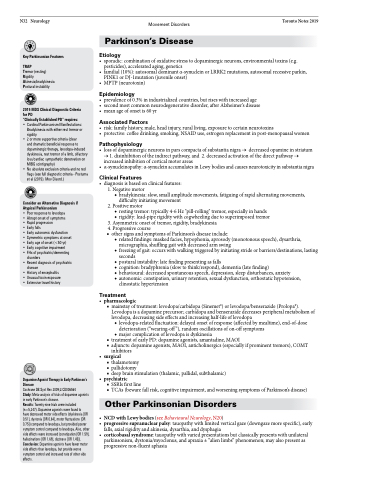Page 774 - TNFlipTest
P. 774
N32 Neurology
Key Parkinsonian Features
TRAP
Tremor (resting) Rigidity Akinesia/bradykinesia Postural instability
2015 MDS Clinical Diagnostic Criteria for PD
“Clinically Established PD” requires:
• Cardinal Parkinsonism Manifestations:
Bradykinesia with either rest tremor or
rigidity
• 2 or more supportive criteria (clear
and dramatic beneficial response to dopaminergic therapy, levodopa-induced dyskinesia, rest tremor of a limb, olfactory loss/cardiac sympathetic denervation on MIBG scintigraphy)
• No absolute exclusion criteria and no red flags (see full diagnostic criteria - Postuma et al (2015). Mov Disord.)
Movement Disorders Toronto Notes 2019 Parkinson’s Disease
Etiology
• sporadic:combinationofoxidativestresstodopaminergicneurons,environmentaltoxins(e.g. pesticides), accelerated aging, genetics
• familial (10%): autosomal dominant α-synuclein or LRRK2 mutations, autosomal recessive parkin, PINK1 or DJ-1mutation (juvenile onset)
• MPTP(neurotoxin)
Epidemiology
• prevalenceof0.3%inindustrializedcountries,butriseswithincreasedage
• secondmostcommonneurodegenerativedisorder,afterAlzheimer’sdisease • meanageofonsetis60yr
Associated Factors
• risk:familyhistory,male,headinjury,ruralliving,exposuretocertainneurotoxins
• protective:coffeedrinking,smoking,NSAIDuse,estrogenreplacementinpost-menopausalwomen
Pathophysiology
• loss of dopaminergic neurons in pars compacta of substantia nigra → decreased opamine in striatum → 1. disinhibition of the indirect pathway, and 2. decreased activation of the direct pathway → increased inhibition of cortical motor areas
• α-synucleinopathy:α-synucleinaccumulatesinLewybodiesandcausesneurotoxicityinsubstantianigra
Clinical Features
• diagnosisisbasedonclinicalfeatures: 1. Negative motor
◆ bradykinesia: slow, small amplitude movements, fatiguing of rapid alternating movements, difficulty initiating movement
2. Positive motor
◆ resting tremor: typically 4-6 Hz "pill-rolling" tremor, especially in hands ◆ rigidity: lead-pipe rigidity with cogwheeling due to superimposed tremor
3. Asymmetric onset of tremor, rigidity, bradykinesia 4. Progressive course
■ other signs and symptoms of Parkinson’s disease include:
◆ related findings: masked facies, hypophonia, aprosody (monotonous speech), dysarthria,
micrographia, shuffling gait with decreased arm swing
◆ freezing of gait: occurs with walking triggered by initiating stride or barriers/destinations, lasting
seconds
◆ postural instability: late finding presenting as falls
◆ cognition: bradyphrenia (slow to think/respond), dementia (late finding)
◆ behavioural: decreased spontaneous speech, depression, sleep disturbances, anxiety
◆ autonomic: constipation, urinary retention, sexual dysfunction, orthostatic hypotension,
clinostatic hypertension
Treatment
• pharmacologic
■ mainstay of treatment: levodopa/carbidopa (Sinemet®) or levodopa/benserazide (Prolopa®).
Levodopa is a dopamine precursor; carbidopa and benserazide decreases peripheral metabolism of levodopa, decreasing side effects and increasing half-life of levodopa
◆ levodopa-related fluctuation: delayed onset of response (affected by mealtime), end-of-dose deterioration (“wearing-off ”), random oscillations of on-off symptoms
◆ major complication of levodopa is dyskinesia
■ treatment of early PD: dopamine agonists, amantadine, MAOI
■ adjuncts: dopamine agonists, MAOI, anticholinergics (especially if prominent tremors), COMT
inhibitors
• surgical
■ thalamotomy
■ pallidotomy
■ deep brain stimulation (thalamic, pallidal, subthalamic)
• psychiatric
■ SSRIs first line
■ TCAs (beware fall risk, cognitive impairment, and worsening symptoms of Parkinson’s disease)
Other Parkinsonian Disorders
• NCDwithLewybodies(seeBehaviouralNeurology,N20)
• progressive supranuclear palsy: tauopathy with limited vertical gaze (downgaze more specific), early
falls, axial rigidity and akinesia, dysarthia, and dysphagia
• corticobasalsyndrome:tauopathywithvariedpresentationsbutclassicallypresentswithunilateral
parkinsonism, dystonia/myoclonus, and apraxia ± “alien limbs” phenomenon; may also present as progressive non-fluent aphasia
Consider an Alternative Diagnosis if Atypical Parkinsonism
• Poor response to levodopa
• Abrupt onset of symptoms
• Rapid progression
• Early falls
• Early autonomic dysfunction
• Symmetric symptoms at onset
• Early age of onset (<50 yr)
• Early cognitive impairment
• FHx of psychiatric/dementing
disorders
• Recent diagnosis of psychiatric
disease
• History of encephalitis
• Unusual toxin exposure
• Extensive travel history
Dopamine Agonist Therapy in Early Parkinson’s Disease
Cochrane DB Syst Rev 2009;2:CD006564
Study: Meta-analysis of trials of dopamine agonists in early Parkinson’s disease.
Results: Twenty-nine trials were included (n=5,247). Dopamine agonists were found to
have decreased motor side effects (dyskinesia [OR 0.51], dystonia [OR 0.64], motor fluctuations [OR 0.75]) compared to levodopa, but provided poorer symptom control compared to levodopa. Also, other side effects were increased (constipation [OR 1.59], hallucinations [OR 1.69], dizziness [OR 1.45]). Conclusion: Dopamine agonists have fewer motor side effects than levodopa, but provide worse symptom control and increased rate of other side effects.


